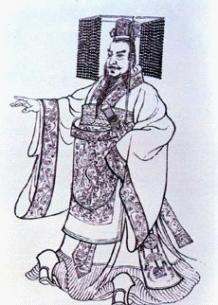HDU 4081 Qin Shi Huang's National Road System (2011北京-次小生成树)
来源:互联网 发布:微软程序员工资 编辑:程序博客网 时间:2024/05/13 16:36
题意:
给n 个点的完全图中 建立一个树, 使得某一个边的两个点权除以其他边距离总和 最大。
思路:
思路很好想:
直接建立一棵最小生成树,使得边权最小, 然后暴力枚举魔法边, 删掉对应生成树上最大的边, 取最大值即可。
但是 不知道这就是 次小生成树, 写的Kruscal算法, 一直TLE, PRIM算法还不会还原树。。
其实次小生成树的的条件 都在这个题目中用到了。
n方求生成树, 并且求出任意两点的最大权。
#include <cstdio>#include <cstring>#include <algorithm>#include <vector>#include <cmath>using namespace std;int T, n;const int maxn = 1000 + 7;struct node{ int x,y,w; void read(){ scanf("%d %d %d",&x, &y, &w); }}p[maxn];double cal(int i,int j){ return sqrt((p[i].y - p[j].y) * (p[i].y - p[j].y) + (p[i].x - p[j].x) * (p[i].x - p[j].x));}bool vis[maxn];double lowc[maxn], cost[maxn][maxn];int pre[maxn];double Max[maxn][maxn];bool used[maxn][maxn];double Prim(double cost[][maxn], int n){ double ans = 0; memset(vis, 0, sizeof vis); memset(Max, 0, sizeof Max); memset(used, 0, sizeof used); vis[0] = 1; pre[0] = -1; for (int i = 1; i < n; ++i){ lowc[i] = cost[0][i]; pre[i] = 0; } lowc[0] = 0; for (int i = 1; i < n; ++i){ double minc = 1e18; int p = -1; for (int j = 0; j < n; ++j) if (!vis[j] && minc > lowc[j]){ minc = lowc[j]; p = j; } if (minc == 1e18) return -1; ans += minc; vis[p] = true; used[p][pre[p] ] = used[pre[p] ][p] = true; for (int j = 0; j < n; ++j){ if (vis[j] && j != p) Max[j][p] = Max[p][j] = max(Max[j][pre[p] ], lowc[p]); if (!vis[j] && lowc[j] > cost[p][j]){ lowc[j] = cost[p][j]; pre[j] = p; } } } return ans;}//int n;int main(){ int T; scanf("%d",&T); while(T--){ scanf("%d",&n); for (int i = 0; i < n; ++i){ p[i].read(); } for (int i = 0; i < n; ++i){ cost[i][i] = 0; for (int j = i+1; j < n; ++j){ cost[i][j] = cost[j][i] = cal(i, j); } } double tot = Prim(cost, n); double ans = 0; for (int i = 0; i < n; ++i){ for (int j = i+1; j < n; ++j){ ans = max(ans, (p[i].w + p[j].w) / (tot-Max[i][j]) ); } } printf("%.2f\n", ans); } return 0;}Qin Shi Huang's National Road System
Time Limit: 2000/1000 MS (Java/Others) Memory Limit: 32768/32768 K (Java/Others)Total Submission(s): 8369 Accepted Submission(s): 2965
Problem Description
During the Warring States Period of ancient China(476 BC to 221 BC), there were seven kingdoms in China ---- they were Qi, Chu, Yan, Han, Zhao, Wei and Qin. Ying Zheng was the king of the kingdom Qin. Through 9 years of wars, he finally conquered all six other kingdoms and became the first emperor of a unified China in 221 BC. That was Qin dynasty ---- the first imperial dynasty of China(not to be confused with the Qing Dynasty, the last dynasty of China). So Ying Zheng named himself "Qin Shi Huang" because "Shi Huang" means "the first emperor" in Chinese.

Qin Shi Huang undertook gigantic projects, including the first version of the Great Wall of China, the now famous city-sized mausoleum guarded by a life-sized Terracotta Army, and a massive national road system. There is a story about the road system:
There were n cities in China and Qin Shi Huang wanted them all be connected by n-1 roads, in order that he could go to every city from the capital city Xianyang.
Although Qin Shi Huang was a tyrant, he wanted the total length of all roads to be minimum,so that the road system may not cost too many people's life. A daoshi (some kind of monk) named Xu Fu told Qin Shi Huang that he could build a road by magic and that magic road would cost no money and no labor. But Xu Fu could only build ONE magic road for Qin Shi Huang. So Qin Shi Huang had to decide where to build the magic road. Qin Shi Huang wanted the total length of all none magic roads to be as small as possible, but Xu Fu wanted the magic road to benefit as many people as possible ---- So Qin Shi Huang decided that the value of A/B (the ratio of A to B) must be the maximum, which A is the total population of the two cites connected by the magic road, and B is the total length of none magic roads.
Would you help Qin Shi Huang?
A city can be considered as a point, and a road can be considered as a line segment connecting two points.

Qin Shi Huang undertook gigantic projects, including the first version of the Great Wall of China, the now famous city-sized mausoleum guarded by a life-sized Terracotta Army, and a massive national road system. There is a story about the road system:
There were n cities in China and Qin Shi Huang wanted them all be connected by n-1 roads, in order that he could go to every city from the capital city Xianyang.
Although Qin Shi Huang was a tyrant, he wanted the total length of all roads to be minimum,so that the road system may not cost too many people's life. A daoshi (some kind of monk) named Xu Fu told Qin Shi Huang that he could build a road by magic and that magic road would cost no money and no labor. But Xu Fu could only build ONE magic road for Qin Shi Huang. So Qin Shi Huang had to decide where to build the magic road. Qin Shi Huang wanted the total length of all none magic roads to be as small as possible, but Xu Fu wanted the magic road to benefit as many people as possible ---- So Qin Shi Huang decided that the value of A/B (the ratio of A to B) must be the maximum, which A is the total population of the two cites connected by the magic road, and B is the total length of none magic roads.
Would you help Qin Shi Huang?
A city can be considered as a point, and a road can be considered as a line segment connecting two points.
Input
The first line contains an integer t meaning that there are t test cases(t <= 10).
For each test case:
The first line is an integer n meaning that there are n cities(2 < n <= 1000).
Then n lines follow. Each line contains three integers X, Y and P ( 0 <= X, Y <= 1000, 0 < P < 100000). (X, Y) is the coordinate of a city and P is the population of that city.
It is guaranteed that each city has a distinct location.
For each test case:
The first line is an integer n meaning that there are n cities(2 < n <= 1000).
Then n lines follow. Each line contains three integers X, Y and P ( 0 <= X, Y <= 1000, 0 < P < 100000). (X, Y) is the coordinate of a city and P is the population of that city.
It is guaranteed that each city has a distinct location.
Output
For each test case, print a line indicating the above mentioned maximum ratio A/B. The result should be rounded to 2 digits after decimal point.
Sample Input
241 1 201 2 30200 2 80200 1 10031 1 201 2 302 2 40
Sample Output
65.0070.00
Source
2011 Asia Beijing Regional Contest
Recommend
lcy | We have carefully selected several similar problems for you: 4085 4082 4089 4090 4087
阅读全文
0 0
- HDU 4081 Qin Shi Huang's National Road System (2011北京-次小生成树)
- HDU 4081 Qin Shi Huang's National Road System (枚举次小生成树)
- HDU-#4081 Qin Shi Huang's National Road System(次小生成树变形)
- hdu 4081 Qin Shi Huang's National Road System(次小生成树)
- HDU-4081-Qin Shi Huang's National Road System(次小生成树)
- hdu-4081 Qin Shi Huang's National Road System(次小生成树)
- HDU-4081-Qin Shi Huang's National Road System (次小生成树)
- HDU 4081 Qin Shi Huang's National Road System(次小生成树变形)
- HDU 4081 Qin Shi Huang's National Road System(次小生成树-Kruskal)
- HDU 4081 Qin Shi Huang's National Road System (次小生成树)
- HDU 4081 Qin Shi Huang's National Road System (次小生成树算法)
- hdu 4081 Qin Shi Huang's National Road System(次小生成树)
- hdu 4081 Qin Shi Huang's National Road System(次小生成树变形)
- hdu 4081 Qin Shi Huang's National Road System(次小生成树变形)
- hdu 4081 Qin Shi Huang's National Road System (次小生成树的变形)
- HDU 4081 Qin Shi Huang's National Road System 最小/次小生成树的性质
- HDU 4081 Qin Shi Huang's National Road System (次小生成树)
- 次小生成树学习小记 Hdu 4081 Qin Shi Huang's National Road System (模板)
- Rancher 中默认运行一个nginx 服务(1个容器),为什么在主机端无法访问该服务?
- Docker 容器
- Linux常用命令
- java验证码制作
- 斐波那契系列问题的递归和动态规划
- HDU 4081 Qin Shi Huang's National Road System (2011北京-次小生成树)
- 字符串的全排列(包括去重)
- JDBC通用类
- cookie中取值
- md5加密类
- 数据类型转换之 string 与 CString
- Glass Carving- CodeForces
- 编码过滤器(utf-8)
- Android Transition FrameWork实现转场动画


